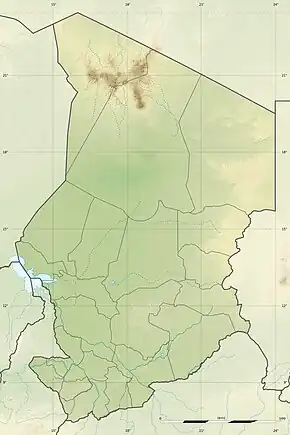| Binder-Léré Faunal Reserve | |
|---|---|
IUCN category IV (habitat/species management area) | |
 Map of Chad | |
| Location | Mayo-Kébbi, Chad |
| Nearest city | Mayo-Kébbi, Chad |
| Coordinates | 9°40′00″N 14°28′00″E / 9.6666°N 14.4666°E[1] |
| Area | 1,350 km2 (520 sq mi) |
| Established | 1974 |
| Official name | Réserve de faune de Binder-Léré |
| Designated | 14 November 2005 |
| Reference no. | 1561[2] |
The Binder-Léré Faunal Reserve, in south-west Chad, bordering Cameroon, was established in 1974 covering an area of 1,350 square kilometres (520 sq mi).[1][3] It has been designated as a Ramsar site since 2005.[2]
Geography
The terrain which lies in an elevation range of 400–500 metres (1,300–1,600 ft) has rock exposures and eroded soils. It forms a transition zone between open forest and savanna woodland. The park is drained by The Mayo-Kébbi River flowing from east to west and Gauthiot Falls lies here. On the western part of the reserve there are the Léré Lake and Tréné Lake through which the Mayo-Kébbi flows. The river runs in a westerly direction, enters Cameroon, then Nigeria and finally debouches into the Niger River system. The Léré Lake has a length of 14.5 kilometres (9.0 mi) with a width of 4 kilometres (2.5 mi). The Tréné Lake has a length of 6 kilometres (3.7 mi) and width of 2 kilometres (1.2 mi). The Touboiris marsh and Loké marsh are close to the headwaters of the Mayo-Kébbi River which is a plain area but outside the limits of the reserve. The mean annual incidence of rainfall in the reserve ranges from 800–950 millimetres (31–37 in).[1]
Flora
Vegetation consists of species of leguminous tree species and Combretum woodland in the southern and northern zones of the reserve. The genera of Anogeissus and Boswellia are the dominant plants.[1]
Fauna
Migrant Palearctic waterbirds are recorded in Léré Lake and Tréné Lake. Falco naumanni and two species of the Sahel biome are also reported from the reserve. Trichechus senegalensis is found in fairly good numbers; 100 numbers were reported in the 1980s. However, poaching by hunters from Cameroon is very extensive and a wildlife monitoring system with village guards has been instituted.[1]
References
- 1 2 3 4 5 "Chad" (pdf). Birlife International Organization. Retrieved 16 October 2013.
- 1 2 "Réserve de faune de Binder-Léré". Ramsar Sites Information Service. Retrieved 25 April 2018.
- ↑ "Binder-Léré Faunal Reserve". Protectedplanet.net. Archived from the original on 24 October 2013. Retrieved 18 October 2013.